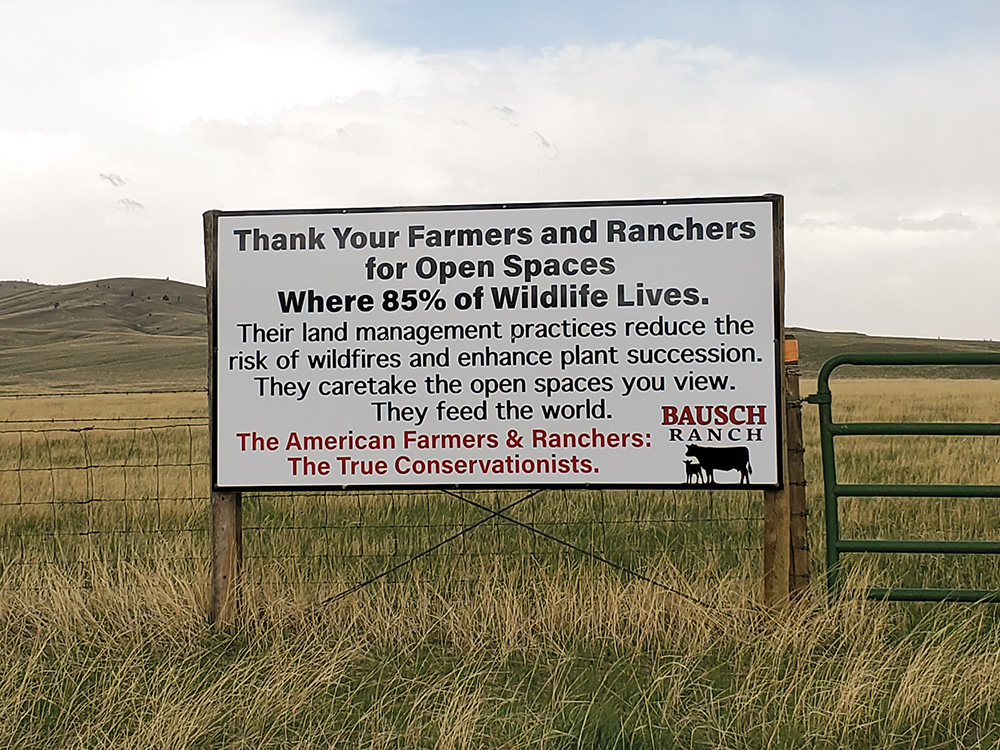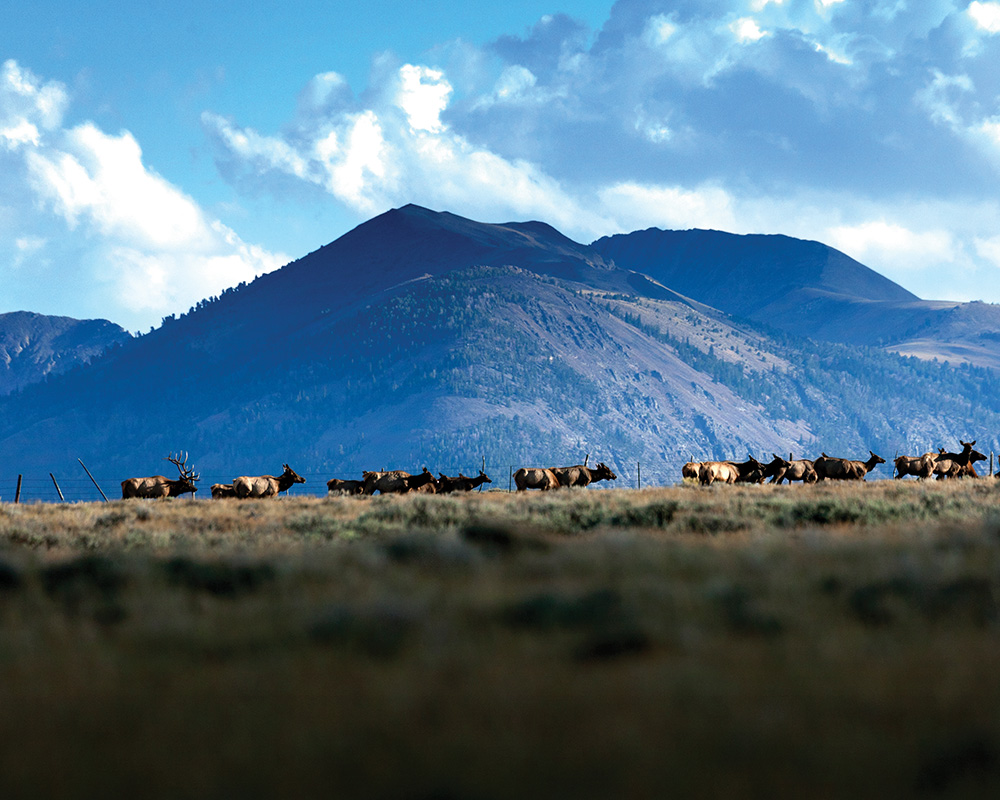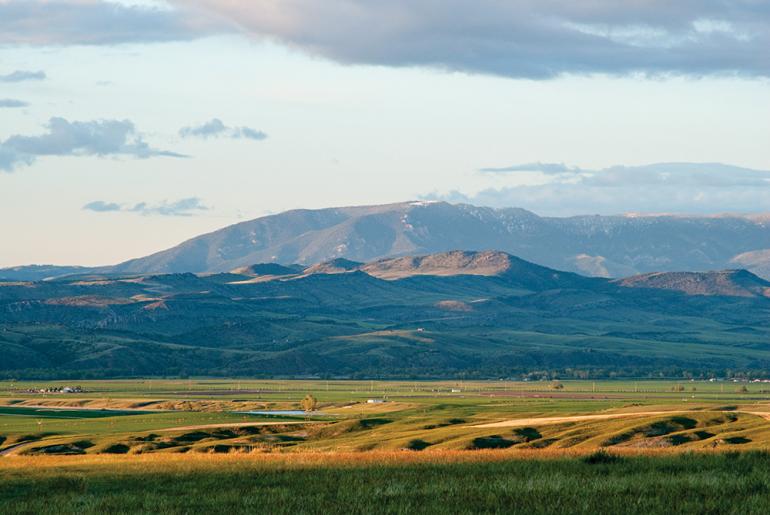Animal House
The public benefits of private lands.
As we extol our public lands—of which we can be justly proud—let us not overlook the importance of private working lands. For these are the most valuable lands in Montana, in terms of healthy soil and water, and in providing essential food and habitat for our state’s treasured wildlife.
Montana is a big state encompassing some 33 million acres of state and federal lands. In southwest Montana, land ownership is split roughly 50-50 between public and private. For the 18 million acres that comprise the Greater Yellowstone Ecosystem (GYE), the ratio moves up to 75 percent public land.
These large expanses of public land provide much of the rich recreational offerings the state and GYE region afford. As research by Headwaters Economics and others has repeatedly demonstrated, the quality-of-life amenities that public lands generate are important economic assets that attract businesses, workers, retirees, and tourists alike.
The importance of public lands and the need to protect them is a common theme in and around southwest Montana and the GYE—as it should be. But the most valuable lands in terms of soils, water, and biodiversity are found in private hands. This is the result of historic settlement patterns in the mid-to-late 1800s as ranchers and homesteaders claimed the best soils, best access to water, and most favorable climates. Beginning in 1872, Yellowstone National Park and the first forest reserves were carved out of the unclaimed remainder, with additional public lands to follow. This pattern is clear today as private lands generally occupy the region’s valleys and foothills while the higher elevations of rock and ice are public.
Countless studies have documented the biological richness of the GYE. It is routinely described as “one of the largest nearly intact temperate zone ecosystems on Earth.” It is a region renowned for its geological wonders, abundant wildlife, and scenic vistas. But often overlooked, amidst all the superlatives, is the tremendous importance of the region’s private lands and the owners who maintain them as working lands. These ranchers and farmers are the stewards of many of the things we enjoy most about living in this region—from abundant wildlife to healthy landscapes. As a sign near Norris proclaims, Thank Your Farmers and Ranchers for Open Spaces Where 85% of Wildlife Lives. They caretake the open spaces you view. They feed the world.
The GYE was formed by titanic geological forces and carved by glaciers and the resulting rivers. The region’s culture reflects similar forces that forged an independent, resilient spirit that is sustained today by a diverse mixture of agricultural, industrial, and commercial activities. Today, as in the late 1800s, a dominant land use in the region is ranching and farming. The region’s open spaces and agricultural traditions work to preserve its rural character. These working lands are essential parts of the local economy—both for what they produce (e.g., cattle and hay) and what they conserve (e.g., open space and wildlife habitat).

While the ecological importance of private working lands in the west is often overlooked, scientists, land managers, and conservation practitioners alike are increasingly mindful that private lands play an outsized role in the overall protection of the GYE. Though smaller in overall acreage, they are critical to the long-term health and sustainability of wildlife, including elk, pronghorn, mule deer, gray wolf, and grizzly bear.
Drive along the Madison, Yellowstone, Shoshone, Henry’s Fork, and any other river valley in the region and the importance of private lands is plain to see. The open space and wildlife habitat maintained by ranchers and farmers function as permanent and seasonal refuges for wildlife, and as secure areas where wildlife find greater respite from human disturbance than on the surrounding public lands, which is increasingly teeming with hunters, anglers, hikers, mountain bikers, climbers, backcountry skiers, and other recreationalists.
But this abundance of habitat is not guaranteed for the future. Unlike lands in the public domain, the future of private lands depends on continued economic viability—they are not called “working lands” for nothing. While Forest Service or Bureau of Land Management lands need not provide a positive return on investment (ROI) as a condition for remaining in public ownership, private lands do or, in the absence of one, they will be sold and/or converted to another use—think grassland to row agriculture, intact open space to residential development. (Consider here the popular Montana bumper sticker, Cows Not Condos.) Population growth, soaring land costs, and volatile agricultural prices, coupled with the challenges of recruiting the next generations to continue the working lands business, weigh heavily on the rancher and farmer. These pressures will only increase as more of us elect to live in attractive areas with natural landscapes and ample outdoor recreational opportunities.
Add to the ROI equation the fact that living with wildlife is not all wine and roses. Wildlife can and do impose burdensome costs on the landowners. These costs take a variety of forms, including competition for forage, crop damage, fencing and gardens, disease risk, and increased trespass by hunters (including shed hunters). In a survey of landowners in the Paradise Valley I recently conducted, 81 percent stated that they suffered economic impacts from wildlife, with elk being the primary culprit.
Because working landowners such as ranchers and farmers are critical to ensuring the future conservation of many species of wildlife, making ranching and farming more profitable and sustainable is not only an important economic goal, it is also a vital conservation goal. Amid a growing public interest in ensuring the future of elk populations in the GYE, for example, the essential role of ranchers and other landowners is gaining more recognition. From a conservation perspective it is important to understand and incorporate the perspectives of landowners who bear the costs of living with wildlife into state and federal policy and budget decisions. As one Paradise Valley ranchers confided to me, “I’m more than just another stakeholder; it’s my land, and my livelihood.”

Ranchers and farmers in the GYE support wildlife every day. While they may not consciously set out each morning with the goal of conserving wildlife, the same land that supports livestock provides forage and security for wildlife. Some landowners proactively include wildlife in their management plans, but virtually all GYE working landowners who invest time, energy, and money into raising a crop, be it cattle or grain, are also investing those same assets into providing for wildlife. As Montana Fish, Wildlife & Parks Director Martha Williams recently noted in Montana Outdoors, “We cannot sustain the wildlife populations we’ve so long enjoyed without farmers and ranchers.”
At a Society of Range Management conference some years ago, professor Richard Knight at Colorado State University asked the question, “Do ranchers (the noun) and ranching (the verb) qualify as keystone species based on their ecological, economic, and cultural importance?” Dr. Knight’s conclusion was that “ranch families working viable ranches that sustain ecosystem services and contribute to the social fabric and local economies are critical to a West that works.”
Rural Respect
The weekend looked to be a beaut. Cup of coffee in hand, I contemplated how to enjoy the great outdoors after a long work week. Suddenly the dog bristled and growled.
Heading out front, I saw a three-quarter-ton pickup angled across the end of the drive, its muddy front tires sunk into the lawn I worked so hard to keep green and weed-free. Hearing voices, we went to investigate. On the far side of the truck were a strange man and woman making themselves at home.
With well-worn ropers propped on the garden wall, faces to the sun, cans of beer in hand, two cattle dogs at their feet, and litter cast to the ground, they had certainly gotten comfortable.
“Nice spot you have here,” the man observed. “We decided to get off the ranch for a day and come over the hill, to take in the sights and get our minds off the daily grind.”
“Hope you don’t mind,” the woman added. “We didn’t see any No Trespassing signs, so we decided to come on in.”
This scene may sound zany and contrived, but reverse the roles and it is a scene replayed dozens of times each weekend as people pour out from the increasingly urbanized environs of Bozeman and into the surrounding rural areas, seeking recreation and enjoyment. While few of us would ever consider helping ourselves to a city-dweller’s front lawn, do we extend that same consideration to our rural neighbors?
A hot summer weekend brings out boaters, floaters, and rafters to the region’s rivers and lakes. And now it is the riparian landowners finding strangers on their property. The noise, litter, and drunken behavior are all too common. Montana’s stream-access law is one of the strongest in the West for its public-access provisions, but many riparian landowners I have spoken with note that the privileges of living along the water are increasingly dampened by the public trespass they experience.
The picture is much the same off-river, as hikers and bikers speed down dirt roads to get to their trailhead destinations, and shed hunters ignore posted property in search of antler treasure. Likewise for anglers ranging beyond the limits of high-water marks.
As we travel around southwest Montana and the Greater Yellowstone Ecosystem, enjoying our right to seek solace and rejuvenation on our cherished public lands, let’s respect the rights of private landowners, too. Let’s appreciate the hard work they put into keeping their lands as open space, preserving the rural character of the landscape, and providing vital homes for wildlife. —Whitney Tilt
Whitney Tilt is a principal at Conservation Benchmarks in Bozeman, focusing on natural-resource-conservation issues—working to identify common ground and sensible solutions. Whitney authored The Flora of the Yellowstone and is a co-founder of High Country Apps, developing interactive field guides for smartphones and tablets, including Fishes of Montana.












